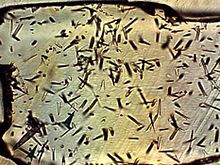
The Zing of Zircon, Part 6: Terrestrial Timepieces
Share
Because zircon crystals often contain impurities of radioactive isotopes, zircon has been an important material used in the development of radiometric dating techniques, and it continues to participate in radiometric dating experiments to this day. Radiometric dating uses what is known about the radioactivity of certain elemental isotopes to determine the age of a particular material sample. There are many methods for obtaining a material’s radiometric age, and zircon crystals almost perfectly meet the parameters for “uranium-lead dating” as they frequently incorporate radioactive uranium isotopes, such as uranium-235 or uranium-238, but do not incorporate lead from the surrounding environment during their formation; as uranium isotopes undergo radioactive decay, they eventually change into nonradioactive isotopes of lead, either lead-206 or lead-207, and the ratio of uranium to lead in a given material sample can be used to discern the material’s age when referenced against uranium’s radioactive halflife.

A 250µm zircon crystal viewed under high magnification; Image: Wikipedia
The uranium content of zircon crystals also makes them good candidates for fission-track radiometric dating. Certain radioactive isotopes of uranium, like uranium-238, will undergo nuclear fission during as part of their radioactive decay, often releasing gamma radiation in the process which then has the potential to damage or disrupt the integrity of materials in its immediate path, leaving a trail or “ion track” of damage in its wake; the concentration of ion tracks in a given material can be used to determine the number of fission events which have taken place since its formation, and referencing this value against the halflife of uranium-238 then indicates the material’s age. Using zircon crystals to radiometrically date materials is an important part of current geological research, augmenting investigations into the formation of igneous rocks, the origins of sediments, the movement of mountain belts, and the age of undated rock layers or “strata”. Radiometric dating of zircon crystals is also sometimes utilised in archaeological research to determine the age of some rock-bearing artefacts.

Ion tracks in a mineral sample made visible by chemical etching; Image: Wikipedia
Zircon’s ability to resist weathering and high temperatures allows zircon crystals to survive in the Earth’s crust for much longer periods of time than virtually any other mineral. Because of this, there exist certain zircon crystals which are regarded as the oldest crystallised mineral formations on planet Earth; zircon crystals from the Narryer Gneiss Terrane in Western Australia, part of the Yilgarn Craton rock formation, have been dated to over 4.4 billion years ago based on the results of uranium-lead dating, making these crystals older than any other dated mineral formation and nearly as old as the Earth itself. Due to the longevity of zircon crystals, many samples are not only present during intense geological shifts but they also frequently survive them; this in combination with the slow continuous crystal growth which occurs for many zircon crystals after their initial formation allows some older crystals to be used as records of the geological changes that they were subjected to, thus providing insight into the early history of planet Earth. Individual stages of crystallisation will carry traces of what the environmental conditions surrounding a crystal were like during that stage of growth, freezing a snapshot of those conditions in time within a crystal, much like a stony time capsule. The layers of a zircon crystal can then be interpreted in a manner reminiscent of how one may read the rings of a tree trunk, revealing information about the geology of a given period during the crystal’s time in the Earth’s crust. Multiple variables within the structure of zircon can provide different pieces of information about the environment in which it grew, such as which impurities are present, the concentration of impurities, the integrity of zircon’s crystal lattice, and the isotopic characteristics of zircon’s intrinsic chemical structure. Interestingly, two pieces of significant information about the ancient days of planet Earth are attributed directly to the analysis of zircon crystals: some zircons from the Narryer Gneiss Terrane dated to 4.4 billion years ago contain isotopes of oxygen which suggest that liquid water may have already been present on the surface of the Earth during their formation, and some zircons from this same region dated to approximately 4.1 billion years ago contain traces of carbon isotopes associated with the biological process known as “enzymatic carbon fixation”, suggesting that living beings were already present and active during that period of Earth’s history.
A zircon crystal from the Mud Tank Zircon Field in Australia’s Northern Territory; Image: Mindat/ Rob Lavinsky
Cross-section of a zircon crystal showing the its layered growth structure; Image: Wikipedia
© Yaĝé Enigmus






